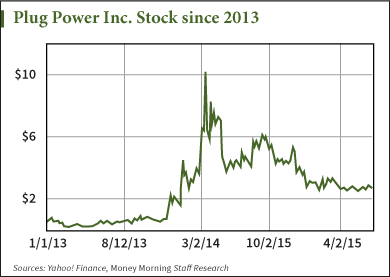 Last year, commercial hydrogen fuel cell vendor Plug Power Inc. (Nasdaq: PLUG) was a darling.
Last year, commercial hydrogen fuel cell vendor Plug Power Inc. (Nasdaq: PLUG) was a darling.
It climbed 565.2% in three months, settling at $10.31 by March 10, 2014.
But PLUG stock got hurt when short seller firm Citron Research released a report that, among other things, accused management of misleading investors and breaking promises left and right.
The firm pointed out that Plug Power consistently failed to meet guidance on fuel cell shipments and revenue.
Citron deemed the stock a "speculative moonshot" - a "casino stock." Citron Executive Director Andrew Left put a $0.50 price target on PLUG stock.
PLUG stock is down 74% since its March 2014 highs and has a rather high short interest - a percentage of investors shorting a stock - of 19.3%. The S&P 1,500 has an average short float of about 6%.
But is Left right? Is PLUG stock an overhyped penny stock with little value over the long haul? Or is PLUG stock a buy?
Let's first take a look at what exactly Plug Power is...
What Does Plug Power Inc. (Nasdaq: PLUG) Do?
For several years Plug Power was a hydrogen fuel cell company trying to find its identity.
In the first decade of its existence, beginning in 1997, Plug Power's main commercial product was GenCore, an on-site electricity generation system using hydrogen fuel cells. GenCore would provide back-up power for telecommunications, broadband, and utility applications.
But in April 2008, with the arrival of CEO Andrew Marsh, the company shifted focus. Marsh saw a thin market for the GenCore back-up systems and instead built the company around the GenDrive product line.
GenDrive is centered on hydrogen fuel cell batteries for forklifts in distribution centers. The aim is to replace cumbersome lead-acid batteries, with a more fuel-efficient alternative.
GenDrive aims to keep forklifts running at full speed for longer than the lead-acid alternatives, reduce operational costs, produce zero emissions, and provide for more commercial space as distribution centers do away with battery rooms that typically take up 7% of these warehouses.
Plug Power was helped in part by an eight-year extension in October 2008 of an investment tax credit for fuel cell technology, for which the GenDrive product line qualifies.
This has helped Plug Power amass an impressive portfolio of business clientele. Its largest customer is Wal-Mart Stores Inc. (NYSE: WMT), but other notable customers include Sysco Corp. (NYSE: SYY), Procter & Gamble Co. (NYSE: PG), Kroger Co. (NYSE: KR), and the Coca-Cola Co. (NYSE: KO).
Despite Marsh's push into what was perceived to be a more profitable business line, PLUG stock was struggling. PLUG stock traded for less than $1 beginning in August 2012, and it took until December 2013 for the stock to push back over that figure.
In that time, the Nasdaq exchange threatened to de-list PLUG stock. PLUG stock traded as low as $0.12 on Feb. 26, 2013.
But, PLUG stock began to take off in December 2013 when Marsh said he planned on the company delivering $70 million in revenue for 2014.
Since 1997, Plug Power has failed to turn a profit. To that point, the company had accumulated a net loss of $849.7 million and delivered a cumulative negative $15.78 earnings-per-share figure.
And this is where the story of PLUG stock became more intriguing...
PLUG stock was on a lot of investors' "Buy" radars coming into 2014. But after its 565% surge, Citron Research released its report on how Plug Power had a bad habit of overpromising and under-delivering.
"We warn investors. You cannot trust management guidance...not even a little bit," the report said. It added that Plug's history of promises "are not just misses but complete fabrications" and questioned "why is any of this going to change?"
This sent the stock back down to where it is now, hovering around $2.70. And Citron turned out to be right.
Plug Power grew sales substantially in 2014, from $26.6 million in 2013 to $64.2 million - a 141.5% increase. But Plug Power fell short of the $70 million in sales promised by Marsh. The company also posted a $88.8 million loss for 2014 – the second largest in Plug Power history after going $121.7 million in the red in 2008.
[epom key="ddec3ef33420ef7c9964a4695c349764" redirect="" sourceid="" imported="false"]
So, what's next for PLUG stock?
Should I Buy PLUG Stock?
It's not a matter of whether Plug Power will be the leader. The company holds a 90% market share for fuel cells in the material handling industry.
It's whether that market is a lucrative one. Hydrogen fuel cells have drawn some high-profile skeptics, including Tesla Motors Inc. (Nasdaq: TSLA) CEO Elon Musk, who called hydrogen fuel cell vehicles "mind-bogglingly stupid."
But if PLUG can continue to enlist high-profile clients like they have with Wal-Mart, they don't need Musk's endorsement, especially when it comes to their use in material handling.
Citron is right to say this company has under-delivered, and it certainly is a speculative stock.
Although the future is far from certain for PLUG stock, it's encouraging this company that was once in danger of heading for the pink sheets is now well above that dollar mark.
Jim Bach is an Associate Editor at Money Morning. You can follow him on Twitter @JimBach22.
How do penny stocks work? Investors who jumped in on PLUG stock when it was trading under a dollar experienced huge gains in its 2014 surge. Even now, with the stock down big, investors who bought PLUG stock at the bottom are still up 2,100%! Such is the nature of penny stocks. Here's a look at how they work...


